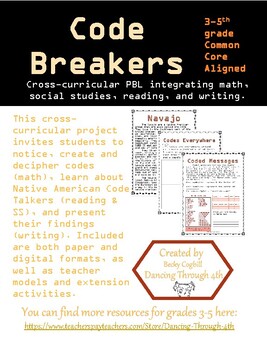Code Breakers SS, Math, Reading, Writing PBL/ Distance Learning
- Zip
- Google Apps™

What educators are saying
Description
This cross-curricular project invites students to notice, create and decipher codes (math), learn about Native American Code Talkers (reading & SS), and present their findings (writing). Included are both paper and digital formats, as well as teacher models and extension activities. It is engaging for students and low-prep for the teacher!
This product includes 3 versions of the document for flexible online or offline use! There is a PDF with teacher suggestions, there is a PDF with a printable student packet, and there is a version that can be digitally filled out with Powerpoint or Google Slides. Perfect for an in-school, out-of-school, or distance learning project, with or without internet!
Target skills & content: Patterns, input/output tables, research, note-taking, presenting information, informational writing, Native Americans, text features





